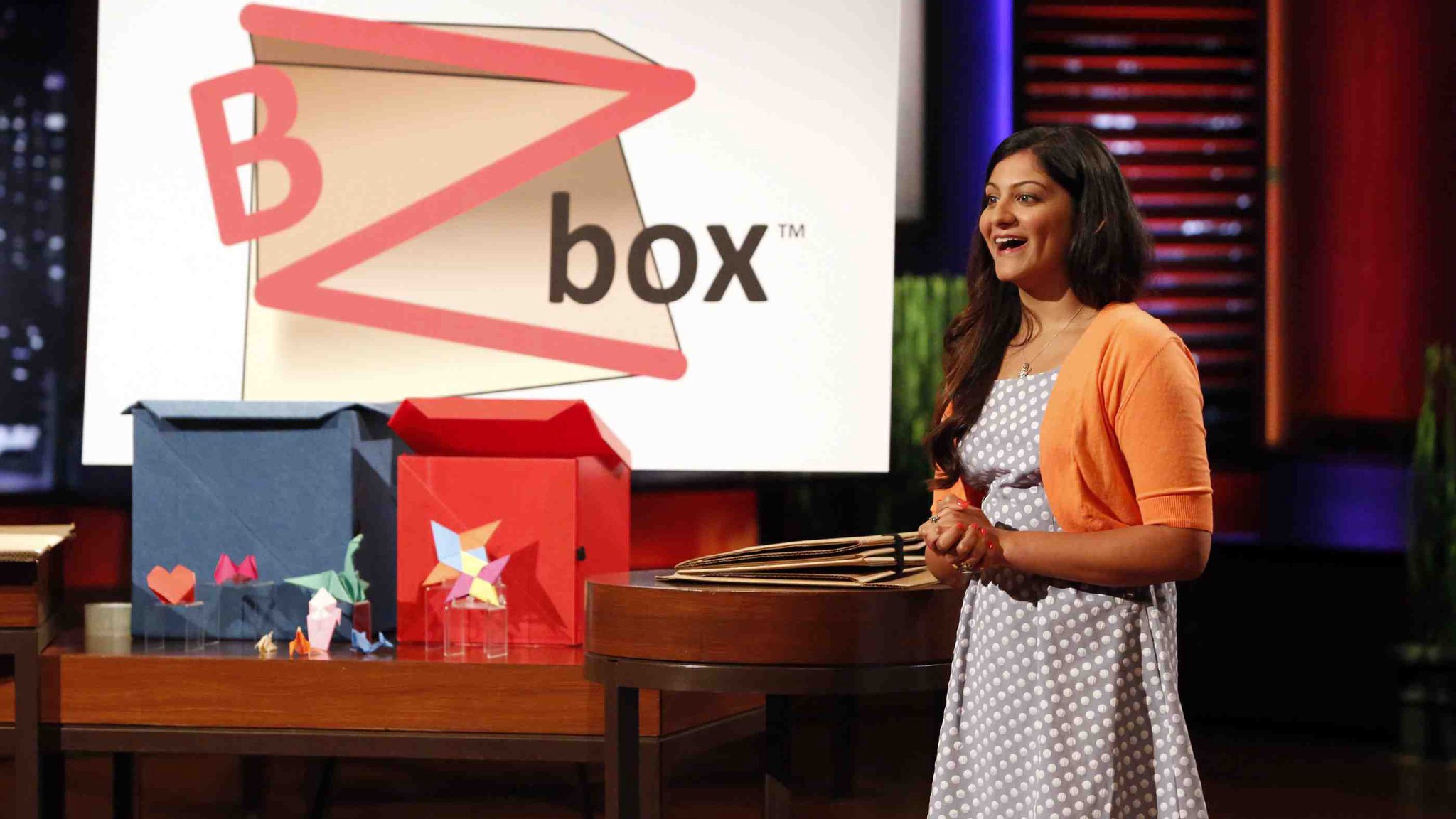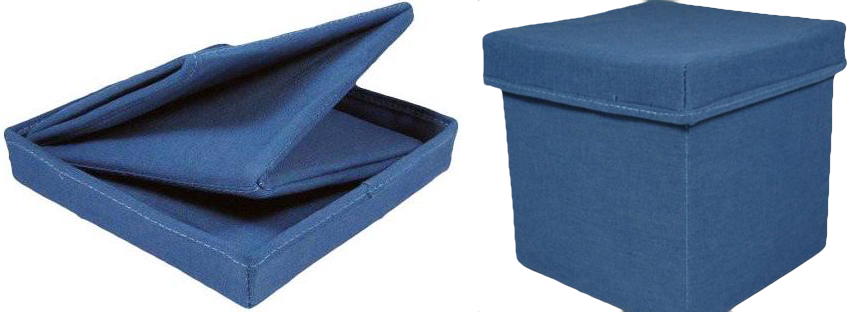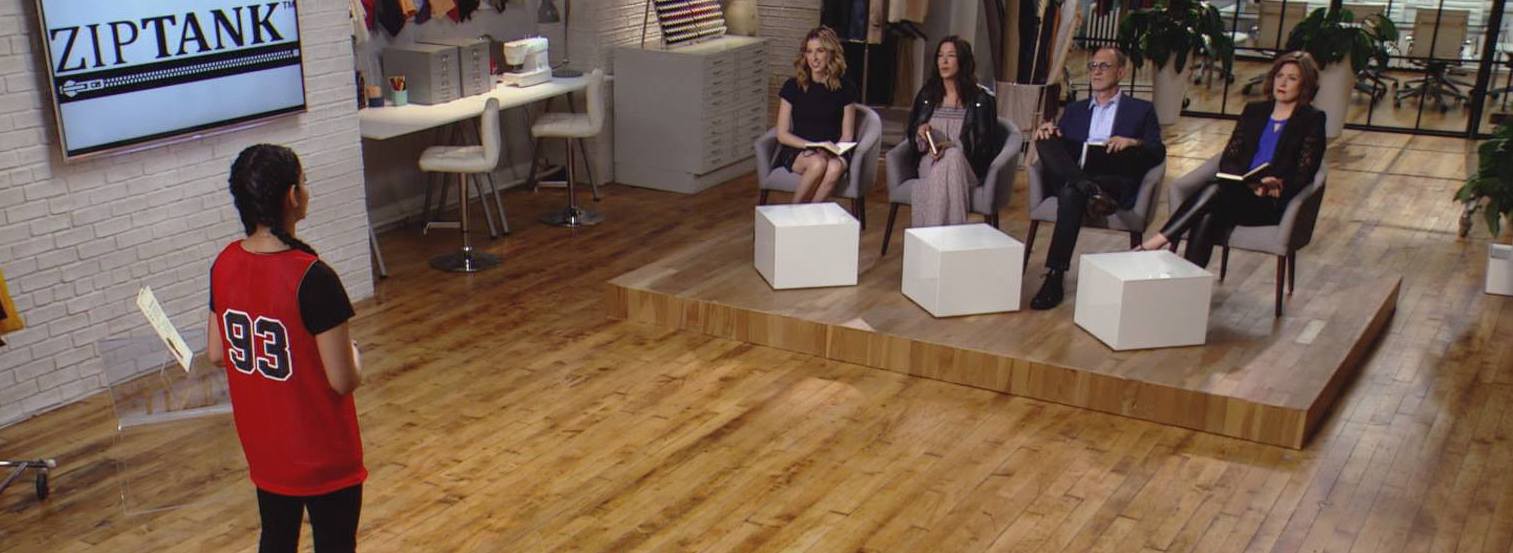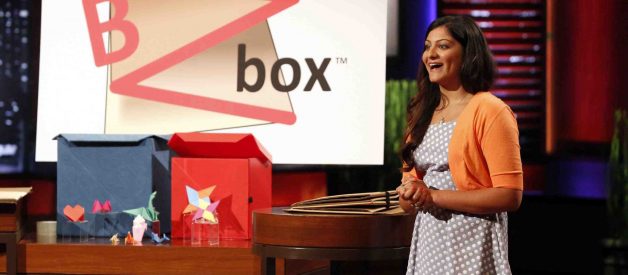The story of a young entrepreneur who took one investor?s job offer over another investor?s check offer for her startup.
 19 year old entrepreneur, Kaeya, pitching the Sharks on ABC?s ?Shark Tank?
19 year old entrepreneur, Kaeya, pitching the Sharks on ABC?s ?Shark Tank?
The Entrepreneur
My love affair with building products began midway through college when I stumbled into my first venture, literally. I stumbled, tripped and fell over my roommate?s clothes that had just fallen out of the cardboard moving box I was carrying from our dorm to the car. She hadn?t taped up the bottom of her moving boxes. I kept thinking that moving in and of itself is enough of a pain, so boxes really shouldn?t require any added effort of tape or assembly.
That summer, I went home and started researching moving boxes. I learned that assembly free moving boxes didn?t exist so I decided to take a crack at designing one and went to Home Depot for materials.
Voila! BZbox was born, a hassle-free box design that incorporated origami so that it would fold flat and pop right open ready for use.
 Early BZbox prototype
Early BZbox prototype
I made some more prototypes and started pitching BZbox in competitions, using the prize money to fund initial startup costs. Then, I had the opportunity to bring those prototypes to the ultimate pitch stage, Shark Tank, even though I still had yet to make a single sale.
I was a clueless 19 year old at the time with zero business acumen, but I managed to land a deal by the skin of my teeth. Those 10 biting minutes on Shark Tank opened more doors than you can imagine, propelling me into a frenzy over the next three years developing micro consumer product brands selling things like skincare, pillows, jewelry, apparel, you name it.
I was able to leverage strategic relationships to secure retail distribution, press coverage, and celebrity partnerships to fuel sales. Revenue that came in from one product was just a vehicle to go build another one. I had no real strategy in place aside from hustling and riding wave after wave that cascaded my way, but it was euphoric. One morning I?d wake up to a Forbes article feature, the next morning there?d be a TV news film crew in my production facility, all of which drove explosive sales.
Then I got a phone call from the producers of a new show called Project Runway: Fashion Startup. The producers invited me to pitch one of my products on the show, which aimed to be a Shark Tank for fashion companies. I had a patented apparel product at the time called ZipTank, a basketball jersey that doubles as a bag with a zipper on the bottom if you can picture that. I figured that if this show could bring in even a small fraction of the opportunities that Shark Tank brought, it would be well worth it. I needed no convincing. I was in.
The producers had informed me that I would be pitching to a panel of four seasoned fashion industry executives who would decide whether or not to invest in the businesses pitched. Those judges were Katia Beauchamp, CEO of Birchbox, Rebecca Minkoff, co-founder of Rebecca Minkoff, Gary Wassner of Hilldun Corporation, and Christine Hunsicker, CEO of Gwynnie Bee.
 Kaeya pitching on ?Project Runway: Fashion Startup.? Investors from left: Katia, Rebecca, Gary and Christine.
Kaeya pitching on ?Project Runway: Fashion Startup.? Investors from left: Katia, Rebecca, Gary and Christine.
My Shark Tank experience taught me that when trying to land a deal, the product itself is not as important as the entrepreneur?s ability to persuade the investors.
Details of the company become important later in the due diligence period. So, this time, I prepped and practiced punchy answers to every possible objection and memorized every last fact and figure. By the time I stepped in front of those judges, I was confident I could steer this conversation.
After some back and forth, Katia and Rebecca bowed out, narrowing it down to Gary and Christine. Gary offered me a deal. I tried to catch Christine?s expression in my periphery to make a judgment call on whether or not I should take it. And then out of nowhere, Christine cut Gary off mid-sentence and jumped into the conversation. At that moment, adrenaline coursed through me. I was invigorated, thinking Christine was about to one-up Gary and start a bidding war for this little product of mine.
Boy was I wrong?
Christine offered me a job instead, a curveball I certainly didn?t expect?nor did anyone else in the room. Even the cameraman filming this episode furrowed his eyebrows.
You know that Looney Tunes cartoon character, Yosemite Sam, who gets beat red in the face and shoots steam out of his ears as the shrieking whistle of a pressure cooker erupts when he?s mad?
That was a picture-perfect description of me at that moment, unbeknownst to the judges though. I wore a convincing poker face but you could have scrambled eggs on my cheeks and steamed dumplings near my ears.
I was livid.
Everyone has their thing. The thing that drives them, that consumes them, the thing that differentiates them, the thing that is core to their identity. Being an entrepreneur is my thing. I work tirelessly day in and day out to grow my company. I get that investors pass on deals all the time. It?s a well-known fact amongst entrepreneurs that raising capital is a long and arduous process filled with a lot of pitches and a lot of no?s.
I can handle no?s. But a job offer? That was unraveling.
Was Christine foreseeing an entrepreneurial train-wreck ahead of me and, out of pity, offering a detour? But instead of coming out guns blazing like my counterpart, Yosemite Sam, I took a minute to cool down and think. As my thoughts swirled, I recalled something Sheryl Sandberg, COO of Facebook, had famously said.
If offered a seat on a rocket ship, get on.
Prior to entering this pitch, I did my research to learn everything I could about the four investors and go into the pitch informed.
I didn?t know what to make of Christine?s company. As my friend and fellow Medium writer, David, pointed out, everyone in tech thinks their company is a rocket ship. If they were right, we would all be dying from fumes, but most companies are simply average.
I didn?t know what to make of the offer, either. I already knew how TV deals go ? and don?t go. Over 60% of Shark Tank deals fall through.
But I knew what to make of the person offering it.
Christine?s entrepreneurial track record is astounding. Not long after graduating from undergrad, Christine worked her way up from employee #8 to President and COO of Right Media, a startup that Yahoo acquired for $850M in 2007. She then led another startup to an acquisition by Facebook.
Now, Christine is disrupting the fashion industry with Gwynnie Bee, a subscription clothing rental service for which members pay a flat monthly fee to continuously rent their everyday wardrobe. Rent The Runway is often credited for pioneering this model, but Gwynnie Bee had actually launched it three years before Rent The Runway.
Standing before Christine and Gary, all I could think was that Christine has been in the business of building rocket ships for a long time. Any aspiring entrepreneur would kill to learn her blueprint, and she just offered me a front-row seat.
So I took it.
The Employee
Shortly thereafter, Christine introduced me to her right-hand man, George Goldenberg, formerly VP of Engineering at Yahoo, and now EVP of Technology, Data and Operations atGwynnie Bee. George spent 30 minutes talking to me about strategy, planning, operations, and execution at scale. He and Christine then proceeded to discuss their strategies for hitting the company?s next milestone, all of which sounded so foreign to me they might as well have been speaking Mandarin. That?s when I knew I was exactly where I needed to be.
I signed on the dotted line and soon saw for myself that Christine, George, and JP, Christine?s co-founder, are leading a team of 400+ staff who are indeed building one hell of a vessel, and Gwynnie Bee is just the tip of it. They had built its technology from Day 1 in Christine?s apartment, with the intention of scaling it as a platform for other retailers to adopt the rental model and participate in the sharing economy.
What will this look like, exactly? In the coming years, you will see more retailers offering clothing rental programs like New York and Company?s and Ann Taylor?s. And it will be Gwynnie Bee?s technology, which they?ve coined ?CaaS?, Clothing as a Service, humming quietly underneath powering every last one of them.
In other words, as Facebook pioneered the new social economy, Uber pioneered the new transportation economy, and Airbnb pioneered the new hospitality economy, Gwynnie Bee is pioneering the new apparel economy with the vision that before you know it, you and everyone you know will be renting part of your wardrobe.
It has been almost a year since I started at Gwynnie Bee and I currently work directly for George ? one of the smartest humans I?ve ever met ? on developing and integrating emerging technologies into the customer experience.
My time at the company so far has been eye-opening. The magnitude of what Christine and her team have set out to accomplish, and the opportunity she and George gave me to trail blaze along side them has been incredible. You may be thinking that Christine didn?t technically invest in me and I don?t blame you. She gave me a job. I am her employee. But as I continue to probe every last crevice of the rocket ship that is Gwynnie Bee, two things are now crystal clear to me.

1. You cannot build a rocket ship without a blueprint.
It?s easy, actually too easy, to spawn an idea, make a pitch deck, and get caught up in the fundraise frenzy. Million dollar seed rounds for paper-napkin ideas are almost as ubiquitous today as McDonald?s establishments. In an effort to scale my company, I got caught up in it too, but it never occurred to me that I may not even have known how to effectively spend that money.
Now, in retrospect, I can wholeheartedly confirm that suspicion because I had no blue print. On top of that, even if I tried to muster one up, I wouldn?t have known where to begin. My entire business hinged on the premise that I could keep getting my products to go viral through mediums like TV, celebrities, influencers, and article features. All of that works, in the short run. My products are a testament to that, but this path is volatile and unpredictable, and therefore not scalable.
It?s no wonder that the failure rate for startups is so astronomical. I have gained so much clarity working with George, racking up a bank of experiences to pull from, that I want to kick myself for starting my first company at 19 despite it being as financially rewarding as it was. George is teaching me know how to build a blueprint and execute on it, which is something you simply cannot teach yourself.
That brings me to Lesson #2.
2. There are actually two types of investors an entrepreneur would be wise to seek out to increase his/her likelihood of long term success.
- The one who invests money.
- The one who invests time.
The two are not mutually exclusive, and ideally investors offer both, but it?s important to understand the distinction.
In seeking financial investment, all money is green and it can come from anyone. Securing it is a sheer volume game. Pitch again and again and someone will whip out their checkbook.
Seeking a time investor, a mentor, is much harder because it can?t just be anyone. Your mentor has to be 100x better than you because if they are only marginally better, they will be too busy covering themselves.
So if you are lucky enough to come across a Christine or George, you would be wise to grab on, even if that means trading in your ?Entrepreneur? card for the ?Employee? card, temporarily, to learn how it?s done.

This story is published in The Startup, Medium?s largest entrepreneurship publication followed by 313,216+ people.
Subscribe to receive our top stories here.



